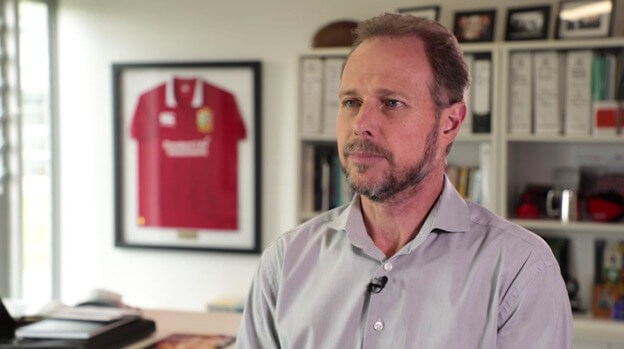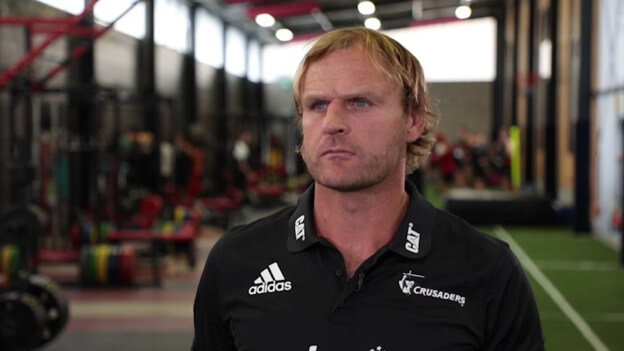Inside the Crusaders: Generating ROI in the Front Office
2017 Super Rugby champions, the BNZ Crusaders, have been using Catapult for the past six seasons and have full buy-in from academy prospects right through to the club CEO.
Chief Executive Officer, Hamish Riach, and Head Coach, Scott Robertson, share their insights into how they quantify their return on investment in technology and use data to remove silos within their performance departments.
Hamish Riach (Chief Executive Officer)

When you think about your return on investment for the Catapult technology, then the main way in which we assess its value to us is in the manner in which the information it provides enables us to tailor programs specifically for our athletes so they stay fit and sound and they’re on the paddock more than they otherwise would be.
The more we know about their load in training, the more we know about their injury loads, and history, and rehab programs, then we’re able to tailor specific programs to those players, which gets them back on the paddock quicker.
The use of technology in and around the playing team at the Crusaders is incredibly important, and we’ve seen the growth and the change and the development in this area – it’s just been massive. In fact, right back at the start of Super Rugby, when our very clever coaches started to look for information to try to understand what was happening in a game, and an individual athlete level, we started playing with technology and got ahead of the game.
Since then, there’s been a raft of technological changes, and therefore the need to stay ahead has never abated. We see our relationship with Catapult as part of being ahead of what others are doing and getting us the information we need to specifically help our athletes to be successful.
What we see and what we hear from our fans is an insatiable desire for knowledge around stats, and we see the Catapult software helping us get some detail that we know will impress and interest fans, so as we start to share that information with them we get a deeper connection with our fans so our fan engagement, they way they feel about the Crusaders, their rugby knowledge, just continues to grow with us and that connection has a whole host of rewards around our fan base and how they want to continue to be fans.
If you think of our young players, what they need to do in terms of their own careers, is understand what they’re good at, what their limitations are, so we see Catapult technology helping us to help them be better.
And that has a couple things in it. One of the things it does is enable us to assess which young talent we think is going to make it, based on stats and information and no guesswork. And secondly, for those guys that are good enough and we see are going to be good enough, they’re getting ready to be professional rugby players because of their ability and their experience with things like Catapult technology right from a young age, and when they get into our environment it’s not so new and different. And so you find that the best young players that have adapted to the technology are quicker to excel once they get here.
Scott Robertson (Head Coach)

As a head coach, Catapult data has been really critical for me, especially with managing our training loads. I work really closely with our head S&C to make sure I line up what we want to do in training and what the boys have had from a game, or pre-season game, or pre-season training, so making it applicable for each week. And then we build the data up through the season, and it was a massive reason for our success last year and winning the championship through getting our load right. It’s direct feedback and also something we can manage moving forward into the season and knowing whether we need to do more or less.
Shaun Owen manages all our load and GPS stuff, working directly with Simon Thomas around the needs of individual players, and then when we do our medical meeting in the morning to plan our week, that data comes back and we look at it in graph form which is really simple and position-specific and player-specific. With the chronic load guys and the under-done guys, we understand what our forward needs compared with a back, and we manage them individually.
It’s just a really simple way of getting the information across.
The technology helps our players maximise what they want as individuals, so we can deal with them as individuals but also understand the history they’ve had and if they’re coming back from an injury, if they’ve played five or six games in a row, whether they’re susceptible to injury, or we need to get more work into them.
For me it’s the load management and injury management and making sure they can play footy. For us, if we get the load right and when the information comes back, it gives them every chance to stay fit and helps manage them through the season.
For us – me and my three assistant coaches – we can walk off the pitch and get instant feedback on the guys that haven’t done the load that they need to or the running they need to, we can deal with it straight away. We’re maximising our time on the field so we don’t need to come back and do it again the next day.
It’s real-life data and we just manage it the best we can and the best for the players.
Read more about Catapult’s work with the BNZ Crusaders here. Click here to learn about the benefits of athlete monitoring.